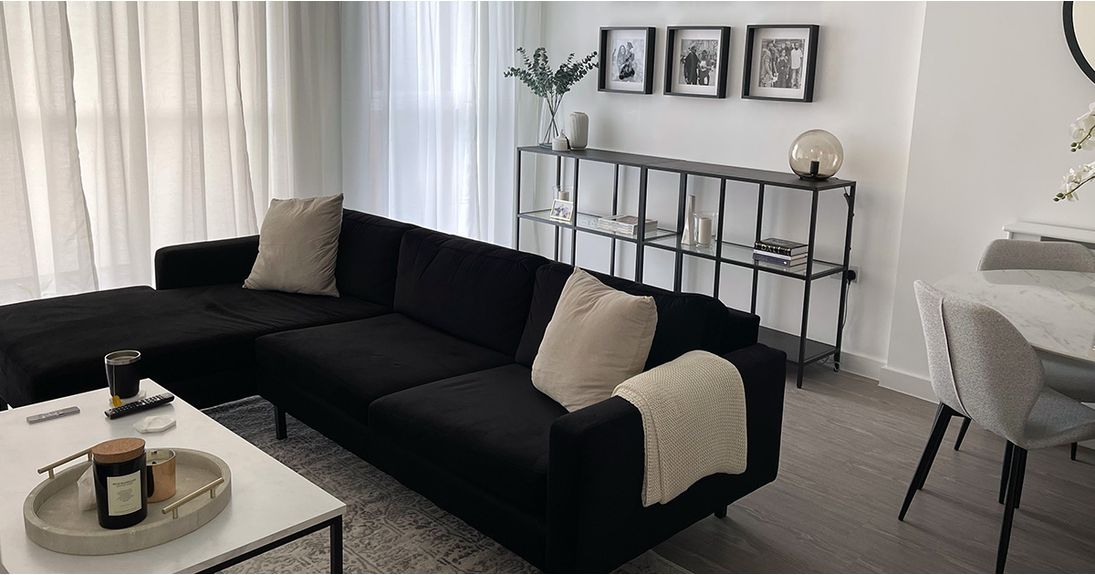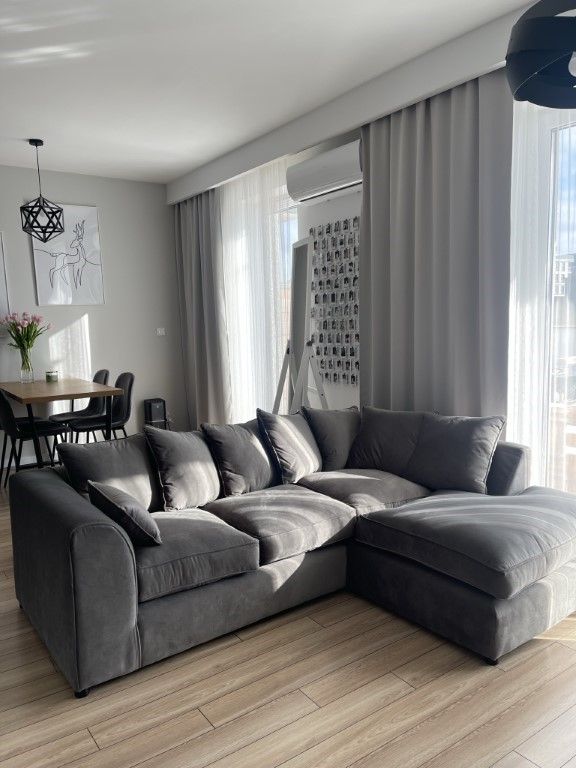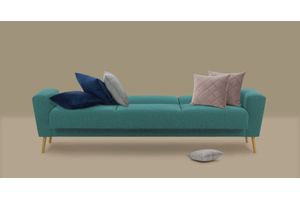
How to decorate a smaller living room? Inspiration and ideas
Making a decision on what furniture you require and that is suitable for a small living room can be quite daunting. It often imposes many limitations, but with some imagination and creativity, these can be resolved. Practicality is the key factor in these decisions, as we need to make sure we get the maximum amount of functionality within the space. So which seating is best - a sofa, a corner sofa, a modular arrangement or armchairs and pouffes? Where do you start with furnishing a smaller living room? We’ll start with the basics.
Furnishing a small living room - what should you consider first?
When starting to arrange a small living room, it is worth paying attention to some basic features of the interior, such as:
- the square footage;
- the shape of the room;
- the location of the windows and doors;
- the amount of light;
- what functions it should fulfil.
Next, it is worth considering the colour palette - choose colours that will optically enlarge the interior. The next step is usually to choose what furniture pieces are needed - cabinets, bookcases, sofas, or armchairs. The last stage is the selection of accessories. It is worth remembering not to have too many of them, so as not to create the effect of overwhelming the interior, which can then make the living room feel smaller. If you have an open plan area, then it is good to separate zones - dining, lounge, and kitchen. This allows you to create a clear, defined, functional space ideal for a living room with a modest area.
Arranging a living room that can double up as an occasional place to sleep, is a consideration when choosing furniture. A sofa bed would be ideal, as it gives you the comfort of a sofa for relaxing in the day, and the versatility to transform it into a room for sleeping at night. If you don’t have a large space though, don’t forget if you are going to buy a sofa bad, that you need to ensure there is enough room to convert it to bed, and also how it converts. There are so many options, such as pull-out beds, fold out actions or a click-clack style that may require you to pull the sofa out into the room further in order to change it into a bed. Look at corner sofa beds, or our popular Flic sofa bed for ideas and inspiration.

How to furnish a small living room?
Once you have chosen your colour palette and furniture pieces, it is time to decide on your style. If you opt for a modern or Scandinavian style, then choose lighter colours for the walls. This will make the living room bright and open. To add interest to the interior the lighter walls would work well with a sofa in a more intense colour, especially a corner sofa, such as the Dillon in a Navy Blue velvet, or Avos in Burnt Orange. If you need coffee tables and sideboards, then choose light wood options, such as Oak or Beech, or even white furniture, to keep the room looking light. Assessing the storage requirements, is important in a small living room. A storage footstool is a great option for keeping magazines, remote controls and laptops neatly tidied away, but still within easy reach. For books look for hanging shelves rather than full bookcase units, to keep the floor space as free as possible.
If your small living room is also required to double up as a place to sleep, it is worth choosing a sofa bed, such as the Flic, or a corner sofa with a storage compartment, such as Amour or Elegance, all offered with a great choice of upholstery options. They are a great way to store your spare bedlinen, pillows and throws.
A small living room in a minimalist style
How do you decorate a living room in a compact apartment or a small flat? Choosing a more minimalist style is a good option – simple designs of furniture and accessories will make the interior feel more spacious and orderly. Muted colours and modest looking furniture are the ideal choice for a small living room, as they keep the room from looking cluttered. Keep the choice of furniture pared back and uncomplicated. Start with the basics and increase the options if the space allows, so firstly decide on the essentials:
- a sofa;
- a coffee table;
- a cabinet or bookcase.
Keeping a small living room simple, with not too many accessories will help to keep the room looking light. But it is important to still add items for interest and add depth to your design. So, enhance your interior with some wall art, such as paintings and photos. Look at adding interest with window dressing to further enhance your scheme, such as patterned curtains or blinds. Minimalism in a small living room will also keep it focused on the functional.
Arranging a small living room - colours, floor coverings, accessories
After planning the required furniture, it is worth thinking about the choice of flooring for a small living room. When choosing the floor, go for neutral colours or a solid surface. A natural light wood colour or a pale carpet will work well.
Choose colours for a small living room to help brighten and lighten the interior. Muted colour palettes used in Scandinavian, minimalist or classic styles will work well. To make the interior cosier and more interesting, it is good to break it up with accessories in vivid, intense colours, such as a rug or cushions in contrasting colours. Wallpaper and pictures are also great for adding character, without taking up any space.

Small living room - inspiration and ideas
After some general tips for furnishing a small living room, it's time to get down to the finer details. In answer to the question "How to decorate a small living room?" We have divided them into several categories:
- living room with an office workspace;
- living room with a dining area;
- small living room with a kitchen;
- a cosy small living room;
- a modern small living room.
How to furnish a small living room with a home office?
Often, even though a living room is small, it may need to provide another function, such as an area for working from home. The first step in furnishing a small living room with a desk as an office workspace is to designate the area in which it will be placed. A corner is usually the best place, but sometimes, a desk behind a well-placed screen, or room divider, is an ideal spot to keep a clear division between work and relaxing.
If your living room is being used for work, then you may need to consider storage, and hidden shelves and bookcases are a great idea in such a multi-purpose space. Think about the chair too, as a stark office chair may not be suitable for a softer living environment, so search for one that either blends in easier in paler colours, or go bold and make the chair a feature of the room. An Albion chair is a perfect example of a chair with multi functioning versatility, as it looks great and is comfortable enough to sit whilst working at a computer, or writing.

How to decorate a small living room with a dining area?
Arranging an open plan living area, that needs to incorporate a living room and a dining room can be a challenge, but with clever zoning it can work really successfully. As it is a small space, then creating zones using a room divider or kitchen island and breakfast bars, may not be options. However, specific areas can be defined in other ways, such as a change in flooring or wall covering, that don’t take any additional floor space.
Ensure the furniture is not too big for the space, as it needs to be functional, but not cluttered. Instead of looking for separate chairs and sofas, then it is worth considering more space efficient seating options, such as a corner sofa and banquette bench seating for the dining area. You need to be able to walk comfortably around your room, without it feeling cramped and awkward.
Small living room with a kitchen
If you have a living room that also has a kitchenette, you need to plan the space very carefully to make sure there is a defined area between food prep and your relaxing haven. The most space efficient and popular way to do this is with a built in breakfast area, that has kitchen storage, a place to eat and space efficient seating. Ventilation is an important consideration, to avoid any kitchen odours transferring to your living space. This can be done with extractor fans or windows, so decide on the best location for your chillout zone and plan accordingly.
In a small living room with an open kitchen, storage is key, as you need to make sure all your kitchen paraphernalia can be easily tidied away out of sight, as you don’t have the luxury of hiding all the mess away behind a door! Shelves and fitted cabinets are the most standard solution, but they don’t have to be boring. Look for brighter colours to liven up the area to make them a feature rather than just a practical necessity.
If you have a little more room, then you may wish to consider a kitchen island, which is a great solution to create a clear, but beautiful and functional separation of individual zones. Bright colours, wood accessories and tall original chairs arranged on three sides will work perfectly. When planning a living room with an island, you need to bear in mind the dimensions of the worktop. Too wide will reduce the space and too long may be impractical.

Creating a small cosy living room
To make a small living room cosy, add textiles to soften the look. Throws and cushions are a great way to achieve this, with minimal expense. The trick with a small space is not to add too much, to avoid making it look cluttered, which can in turn, enclose the room further. Add backlighting behind a bookcase and a slim floor light to give cosier lighting conditions.
A cosy small living room is also about choosing a properly considered style that has been given a personal touch. For some, a Scandinavian style which works great in a small space, can feel austere, so by introducing warmer colours together with tactile fabrics will add a cosy feel.

